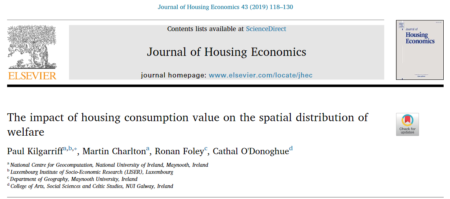Abstract Urban development projects have many effects on society, such as improving mobility, health, education, and sustainability. For policy-relevant measures, it is important that policymakers are able to foresee how quality improvements influence the price of land. Therefore, our objective is to collect a set of variables able to account for the effects of a multitude of land
MonthFebruary 2019
Dis-equalising impact of Housing
https://www.sciencedirect.com/science/article/pii/S1051137718301293 The measure of a household’s income should include not only monetary components such as job salary but also non-monetary components and in-kind benefits, such as imputed rent. Imputed rent is the rent an owner can expect to receive were the house on the rental market. Being an owner-occupier does not provide a rental income
Now there is a formal link between standard intra-urban theory of residential choice and population scaling as of urban systems theory! A must read in Geographical Analysis
Justin Delloye, Rémi Lemoy (now at UMR Idées, Rouen) and Geoffrey Caruso just published an article where they reconcile Alonso and the scaling literature. This is done through an augmented micro-economic model where scaling exponents are explicit and the scaling with population of the profile of residential land is exogenously given to better suit empirical
The land transformation model-cluster framework: Applying k-means and the Spark computing environment for large scale land change analytics
Omrani H., has a new article published in the EMS journal. The paper explores the challenges of simulating land change across large regions and spans of time. The new mode, called LTM-Cluster, is a scalable modeling framework aimed to benefit research involving large datasets. The paper uses the Spark environment to reduce the burden of high computational
Towards place-based exploration of Instagram: Using co-design to develop an interdisciplinary geovisualization prototype
Catherine Jones has a new article published in the Open Access Journal of Spatial Information Science. The paper explores the co-design process of adapting a digital humanities tool for the geovisualisation and exploration of place-based information encoded in Instagram posts. The paper uses data associated to the #Via Francigena cultural route. It reflects upon the process of data




